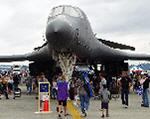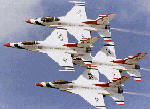
|
Description
| Manufacturer: | Douglas |
| |
| Base model: | TBD | ||
| Designation: | TBD | ||
| Version: | -1A | ||
| Nickname: | Devastator | ||
| Designation System: | U.S. Navy / Marines | ||
| Designation Period: | 1935-1946 | ||
| Basic role: | Torpedo Bomber | ||
| Modified Mission: | Amphibious | ||
| Crew: | Pilot and observer/rear gunner |
Specifications
| Length: | 35' 0" | 10.6 m | |
| Height: | 15' 1" | 4.6 m | |
| Wingspan: | 50' 0" | 15.2 m | |
| Wingarea: | 422.0 sq ft | 39.2 sq m | |
| Empty Weight: | 5,600 lb | 2,539 kg | |
| Gross Weight: | 10,194 lb | 4,623 kg | |
Propulsion
| No. of Engines: | 1 | ||
| Powerplant: | Pratt & Whitney R-1830-64 | ||
| Horsepower (each): | 900 | ||
Performance
| Range: | 716 miles | 1,152 km | |
| Cruise Speed: | 128 mph | 206 km/h | 111 kt |
| Max Speed: | 206 mph | 331 km/h | 178 kt |
| Climb: | 720 ft/min | 219 m/min | |
| Ceiling: | 19,500 ft | 5,943 m | |
Recent comments by our visitors
| steve y. , WA | The SBD was not a plane designed for "high speed" flight. Yet it could dive at 300mph under complete control. It dove from 14,000 feet to 1500 feet, and it over two minutes (that's a LONG TIME to be going 300mph) to reach 1500 feet from 14,000 feet. This is an example of how various wing chords could perform beyond the edges of their "design". The Hawker Hurricane wing is extraordinarily thick (the thickness of the wing was incredible for a fighter). Have you ever stood next to it's wing? The wing is huge. It was a 320mph aircraft and could reach 400mph in a dive. There are many other examples of aircraft with wings "not designed for high speed" that were refitted with more powerful engines which resulted in more speed. The infamous Junkers Ju87 dive bomber had a enormous wing - they kept putting a more powerful engine on it (added 200 more horsepower) without changing it's wing, and they would have increased it even more had they the time and circumstances. It had a top speed of 255mph. In regards to speed, what would be considered "HIGH speed"? 300mph? 350mph? 375mph? 400mph? 450mph? A low-wing all-metal monoplane that can CRUISE at 200 miles per hour is not a structure that has limitations only a few points beyond the maximum speed of a power plant that is only assigned a top speed of 206mph. Right into 1941, even surviving biplane (BIPLANE!) fighters like the Gloster Gladiator could fly at 250mph (It's top speed = 253mph). 03/15/2011 @ 11:17 [ref: 36856] |
| steve y. , WA | The TBD is one of the most mis-understood WWII aircraft. The TBD was simply UNDERPOWERED. The 900hp engine that was installed on it looks like an afterthought. The 900hp that was chosen for it was, for an all-metal, fully modern low-wing monoplane of sound and successful design, far too light for it. An engine UNDER 1000hp for an aircraft of this type of this size (TBD had a FIFTY-foot wingspan!), with the wing chord it had, is recognizably nearly absurd; the thing only managed 201mph maximum speed with that engine on it, which even visibly is clearly to small for the airplane. That 900hp power-plant belonged on a Grumman Duck, or perhaps a highly improved OS2U Kingfisher - NOT on the USN's primary, front-line, principle combat torpedo bomber. This was a substantially large aircraft - it's wing and airframe could carry a TWO-THOUSAND lb. torpedo and a crew of two even WITH that utterly undersized 900hp engine. The TBD could have easily been re-equipped with a 1600hp Wright (that already existed on the Martin Maryland/Baltimore AND also Douglas Boston/Havoc PRIOR to 1940!), though it is apparent that it could have been re-engined with up to a 1700hp Wright (for example, the engine that the initial TBF/TBM was equipped with). Had the TBD been properly powered as such, it would have had approx. 340mph top speed (with a simple single-stage supercharger) up to approx. 16,000ft., and a cruising speed of at least 290mph. This would have made the TBD a very potent low-to-mid altitude bomber aircraft, as effective as the TBF/TBM that replaced it, and probably would have became far more famous contributor to the missions and operations it would have carried out. It was actually quite maneuverable and agile, the pilots reporting that they could do loops and
rolls and perform steep reversals at a low airspeed, while able to perform "to perfection" high speed dives - all of this with the undersized engine! 08/20/2008 @ 00:07 [ref: 22505] |
| Nouri Chahid Prague, Czech Republic, AL | I fully agree with the comment made by Miguel Vasconcelos, of the 03/23/2004 @ 10:53 [ref: 7035] (Migel, send me an email at: nouricz@yahoo.com asap!).
The TBD-1 was completely maxed out by 1941 and it was just there... way too late going into WW-II. A perfect similar exemple of that was the Avia B534 fighter aircraft, made in Czechoslovakia just before WW-II, which, was one of the best fighters in the world flying. You may check: http://en.wikipedia.org/wiki/Avia_B-534 In the end, the wikipedia notes say \\\\\\\'On 10 September 1944, six B.534s were involved in a brief melee with six German Bf 109s at low altitude. One B.534 was lost, but the Germans quickly broke off, wary of the low altitude and the B.534\\\\\\\'s maneuverability.\\\\\\\'... not a bad performance on behalf of the B-534, even though its design was totally outdated and performance incomparable to that of the Bf-109; but totally unsuitable to fight the rest of the war (in less than years we went from that type of aircraft to the P-51!) Esthetically speaking, the TBD-1 Devastator has near perfect, the purest aerodynamic lines you will ever see on an aircraft, yet, they will also tell you it will never be the type of performing aircraft comparable to others... it would have to have a new wing (speed and wing loading), new engine (top-end speed and torque), new airframe (vibration and structural loading) and new empenage (speed, stability&control and structural loading)... a totally new and different airplane Nouri Chahid AE Parks\\\\\\\'92 04/07/2008 @ 02:27 [ref: 20360] |
| j , PA | can anyone tell me the cost and signifigance of the aircraft nickname? why is it called the devastator? how much did one plane cost?
03/02/2008 @ 17:50 [ref: 19840] |
| D. McFelea , CA | Is there anyone out there that can tell me the height, width, and shape of both the wing corregations and the stab corregations?? Any help would be greatly appreciated. 08/28/2006 @ 20:34 [ref: 14018] |
| Thomas F. Evans Leland, MI, MI | On 2/23/2006, I stumbled upon a picture submitted by Steve & Cori Galeener of TBD (Bureau #0297) which had crashed on the Yorktown in Sept 1940 and subsequentlt assigned to Torpedo Squadron Eight and was lost at Midway. My brother, Ensign William R Evans, Jr flew that plane on June 4th 1942. I can't seem to get back to that site. I'd like to obtain a copy of that picture and any other information available. Thank you. 03/30/2006 @ 08:18 [ref: 12976] |
| Lance Nuckolls Frederick, MD | Has anyone written a definitive history about this fine U.S. Navy aircraft? 06/24/2004 @ 15:36 [ref: 7684] |
| Miguel Vasconcelos Germantown, MD | With regards to installing a more powerful engine on the TBD-1, it should be noted that 1935-1937 BuAer flight-testing data clearly showed that the 900 Hp R-1830-64 engine was already at the edge of what the TBD-1 airframe could safely handle, and that at all altitudes. The TBD-1 suffered from extreme vibrations even with the original 850 Hp -60 engine. What Douglas and the Navy did to alleviate the vibration problem only mitigated the problem to some extend, but never eliminated it. I have serious doubts the airframe would have been able to be mated to the 1,200 Hp version of the R-1830 without major modifications.
In addition, the NACA airfoil used for the TBD-1 main plane (the characteristic thick wing) were specifically used by Douglas engineers to meet the Navy's 1934 specifications dealing with lifting and carrying requirement (Mk. XIII torpedo or 2,000 lb. of bombs), and was not a wing that permitted high speed flight. This is illustrated by the aircraft's very low Vne (or never exceed speed) of merely 208. Relevant is the fact that performance and operational data shows that when fully loaded with a Mk. XIII torpedo, 2 men, pilot and radioman/gunner armor, 180 gallons of fuel and other miscellaneous equipment [the conditions used by Torpedo 8 at Midway and 900 lb. over the maximum gross weight]), and at high cruise power settings of +/- 80-85% power, the aircraft could barely maintain 110-115 knots at 2,000 feet. Therefore, putting the vibration issue aside, if a new airfoil was not used, the power requirements to improve performance, even slightly, would have been enormous and to some extend, counterproductive. Miguel Vasconcelos 03/23/2004 @ 10:53 [ref: 7035] |
| Paul Studdard Cp Spgs, CO | When you think about, the basic aerodynamics of the Devastator were not all that bad, especially given its mid thirties origin.
It is interesting to speculate about what kind of Torpedo Bomber it would have made with a more powerful 1200 hp engine (same engine size as the Dauntless and Wildcat), flush riveting, smooth updated wing without the corrugation, deletion of the largely useless middle second pilot/bombardier seat, a little bit of armor plate, conventional retractable landing gear, a fifty for rear defense, and self sealing tanks. And don't forget to mention a better torpedo. I do think whith these changes, especially 33 % more power and increased streamlining, it would not have been a slouch. I think a TBD-2 or TBD-3 could have approached the Grumman Avenger in performance. The Grumman Avenger was not exactly a speed demon. Remember, the Avenger needed air superiority, that was finally available for it when it started its campaigns. The Avenger would have been slaughtered just like the Old TBD Devastator if it would have attacked under the conditions that VT-8, VT-3, and VT-6 attacked under that morning. I think the Avenger with its better performance would have taken a few Zeros with it, but the outcome would have been similar. Anyway no aircraft ever built personifies the raw courage and guts of Naval Aviators in general like the old Devastator. Outgunned, Outflown, but never turning back. The suicidal courage of the TBD crews paved the way for the textbook perfect dive bombing attacks executed by the Dauntless crews. Paul Studdard 05/08/2002 @ 22:22 [ref: 4901] |
| Tyler Stoelting Tampa, FL | The Douglas TBD-1 Devastator is the best (well my favorite) plane in the world. people just need to give the plane a chance. 12/22/2001 @ 20:30 [ref: 3884] |
Recent photos uploaded by our visitors








